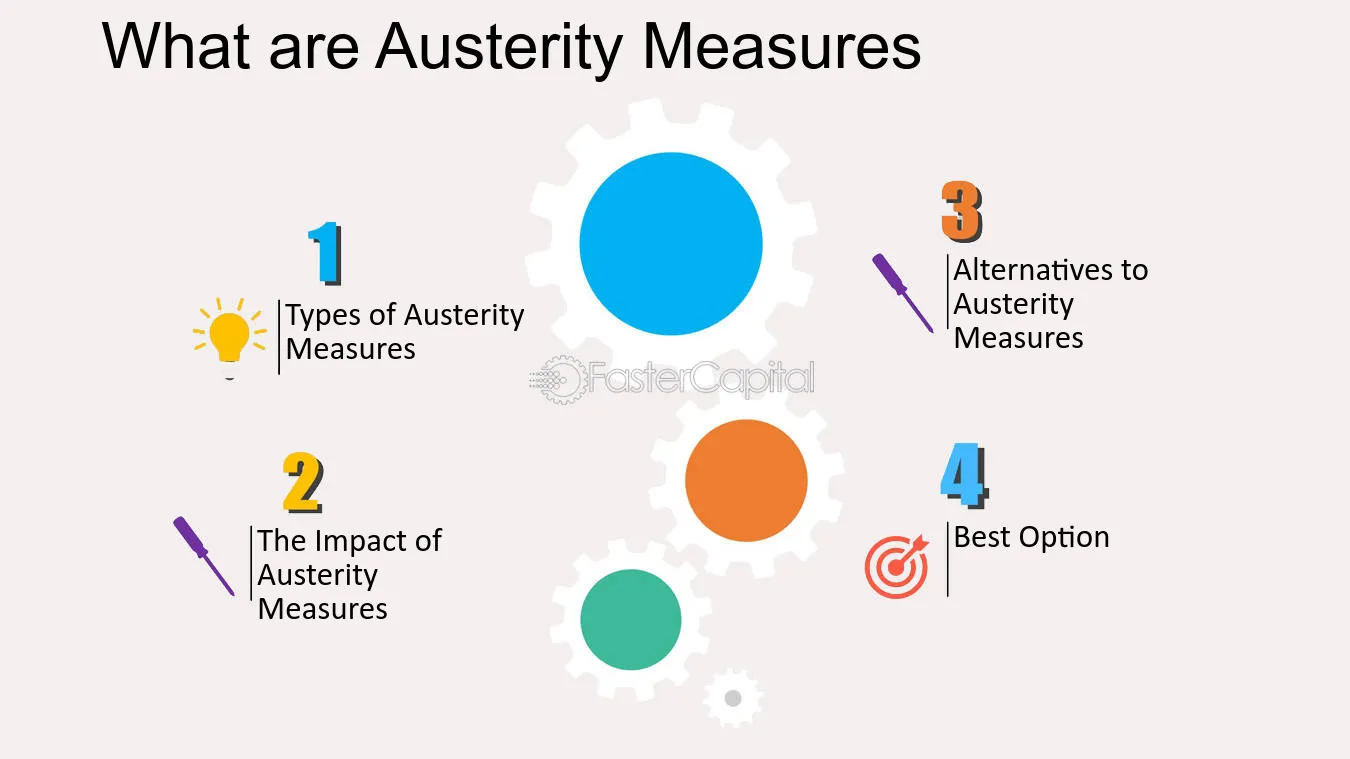Fiscal Austerity Measures

Fiscal austerity measures refer to the actions taken by governments to reduce their budget deficits and control public spending. These measures are typically implemented during times of economic crisis or when a country’s debt levels become unsustainable. The goal of fiscal austerity is to restore fiscal discipline and promote long-term economic stability.
There are several types of fiscal austerity measures that governments can employ:
1. Spending cuts: Governments can reduce their spending on various sectors such as healthcare, education, defense, and infrastructure. This can involve cutting funding for public services, reducing the number of government employees, or implementing wage freezes for public sector workers.
2. Tax increases: Governments can increase taxes to generate additional revenue. This can include raising income taxes, corporate taxes, value-added taxes (VAT), or introducing new taxes on specific goods or services.
3. Pension reforms: Governments can reform their pension systems to reduce the financial burden on the state. This can involve increasing the retirement age, reducing pension benefits, or implementing means-testing to determine eligibility for pensions.
4. Privatization: Governments can sell state-owned assets or enterprises to private investors. This can generate revenue for the government and reduce the financial burden of maintaining and operating these assets.
5. Welfare reforms: Governments can reform their welfare systems to reduce spending on social welfare programs. This can involve tightening eligibility criteria, reducing benefit levels, or implementing work requirements for welfare recipients.
It is important to note that the effectiveness of fiscal austerity measures can vary depending on the specific economic and political context. While these measures can help reduce budget deficits and restore fiscal stability, they can also have negative effects on economic growth, employment, and social welfare. Therefore, it is crucial for governments to carefully consider the potential consequences and implement these measures in a balanced and equitable manner.
Monetary Austerity Measures
Monetary austerity measures refer to the actions taken by central banks to reduce the money supply and tighten monetary policy in order to control inflation and stabilize the economy. These measures are often implemented in conjunction with fiscal austerity measures to address economic imbalances and promote long-term sustainability.
There are several types of monetary austerity measures that central banks can employ:
- Interest rate hikes: Central banks can increase interest rates to discourage borrowing and spending, which helps to reduce inflationary pressures. Higher interest rates make it more expensive for businesses and individuals to borrow money, which can lead to decreased consumption and investment.
- Reserve requirements: Central banks can increase the reserve requirements for commercial banks, which means that banks must hold a higher percentage of their deposits as reserves. This reduces the amount of money available for lending and can help to curb excessive credit growth.
- Open market operations: Central banks can engage in open market operations, which involve buying or selling government securities on the open market. By buying government securities, central banks inject money into the economy, while selling securities removes money from circulation.
- Quantitative easing: In times of economic crisis, central banks may resort to quantitative easing, which involves the purchase of government bonds or other financial assets to inject liquidity into the economy. This measure aims to stimulate lending and investment to boost economic activity.
- Exchange rate adjustments: Central banks can also influence the value of the national currency through exchange rate interventions. By devaluing the currency, exports become more competitive, which can help to stimulate economic growth and reduce trade imbalances.
Monetary austerity measures can have both positive and negative effects on the economy. On one hand, they can help to control inflation, reduce imbalances, and promote long-term stability. On the other hand, they can also lead to decreased consumption, investment, and economic growth in the short term.
Real-life examples of monetary austerity measures include the European Central Bank’s decision to raise interest rates during the Eurozone debt crisis, the Federal Reserve’s implementation of quantitative easing in response to the 2008 financial crisis, and the Bank of England’s use of exchange rate adjustments to support the UK economy during Brexit.
Real-life Examples of Austerity Measures
Austerity measures have been implemented in various countries around the world in response to economic crises or to reduce government spending. Here are some real-life examples of austerity measures:
1. Greece

Greece faced a severe debt crisis in 2010 and was forced to implement austerity measures in exchange for bailout funds from the European Union and the International Monetary Fund. These measures included significant cuts to public sector wages, pensions, and social benefits, as well as tax increases. The implementation of austerity measures in Greece led to widespread protests and social unrest.
2. United Kingdom

In response to the global financial crisis in 2008, the United Kingdom implemented austerity measures to reduce its budget deficit. These measures included cuts to public sector spending, welfare reforms, and tax increases. The government aimed to reduce the deficit and restore economic stability. However, critics argued that the austerity measures disproportionately affected the most vulnerable members of society.
3. Portugal
Portugal also faced a debt crisis in 2010 and had to implement austerity measures as a condition for receiving a bailout package. The measures included cuts to public sector wages, pensions, and social benefits, as well as tax increases. The implementation of austerity measures in Portugal led to a decline in economic growth and high unemployment rates.
4. Spain
Spain implemented austerity measures in response to the European debt crisis in 2012. The measures included cuts to public sector wages, pensions, and social benefits, as well as tax increases. The government aimed to reduce its budget deficit and restore investor confidence. However, the implementation of austerity measures in Spain resulted in a prolonged recession and high unemployment rates.
5. Ireland
Ireland faced a severe financial crisis in 2008 and had to implement austerity measures to stabilize its economy. The measures included cuts to public sector wages, pensions, and social benefits, as well as tax increases. The government aimed to reduce its budget deficit and restore economic growth. The implementation of austerity measures in Ireland led to a significant decline in living standards and emigration.
These real-life examples highlight the challenges and consequences of implementing austerity measures. While they may be necessary to address economic crises and reduce government spending, they often have a significant impact on the population, particularly the most vulnerable groups. It is important for policymakers to consider the social and economic implications of austerity measures and to implement them in a balanced and equitable manner.

Emily Bibb simplifies finance through bestselling books and articles, bridging complex concepts for everyday understanding. Engaging audiences via social media, she shares insights for financial success. Active in seminars and philanthropy, Bibb aims to create a more financially informed society, driven by her passion for empowering others.
